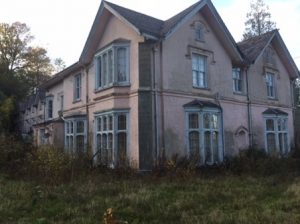We aim to highlight the plight of neglected and at risk eighteenth- and early nineteenth-century listed and unlisted buildings and landscapes that could and should have a brighter future. The publicly nominated buildings on this list have been selected because they are empty and unused, may have been subjected to severe decay and their futures remain uncertain. The list includes once stately country houses, estate outbuildings, a former chapel, a mill and even a London townhouse. This year’s group desperately need our attention, as do those not included on this list, but featured on our Instagram @thegeorgiangroup. Our thanks go to Michelle Behr, for compiling this list.
If you know of a heritage building or landscape that is at risk, please let us know via: atrisk@georgiangroup.org.uk. Please include in your email details of when it was created, its location, and the reasons why you believe it should be included on the Georgian Group’s list, together with one or more photographs.
Here we reveal The Georgian Group’s 2022 Top 10 Most At Risk Heritage (in no particular order):
Wingfield House, South Wingfield, Derbyshire
This neglected grade II-listed villa is in a deplorable condition with the building’s windows and door tinned up and missing windows and evidence of water ingress in the rear portion. The mid-eighteenth century villa, with a range of outbuildings, was substantially enlarged c1840 and set back in what once would have been a fine garden. The house is what would be called ‘a substantial village house’ in modern terms. It was bought by Henry Pearson, a mining entrepreneur in 1770 and held by the family until 1932 when Col. Henry Pearson died without a direct male heir. It was then sold to the YHA and subsequently sold by a local farmer to the Assemblies of God sect. The building has since been abandoned – the interiors were left full of items from the church such as organs, devotional objects, and institutional furniture. It appeared the drawing room was converted to the chapel. This once lovely villa continues to remain empty and neglected, with no signs of movement to improve the situation.
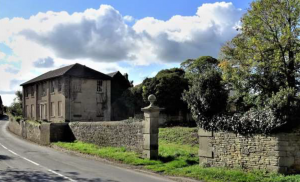
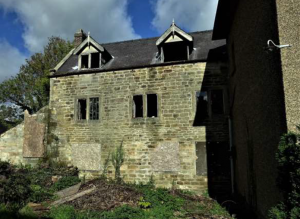
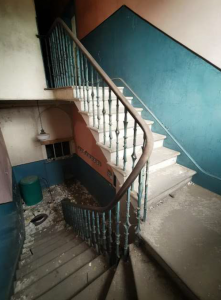
Former Chapel of Ease at Church Hollow, Purfleet, Essex
In shocking condition, this former grade II-listed Chapel of Ease in Purfleet was built in 1791 by Samuel Whitbread of brewing fame who purchased a large portion of Purfleet and lived there at the time. The church was part of three listed late 18th century structures built inside a chalk pit by Whitbread, owner of the quarry, for his workers. They comprised of the Chapel of Ease, schoolhouse, and school master’s house. The former Chapel was converted to a house in the 1920s and has lain derelict for thirty plus years and sadly vandalised. Located between two housing estates in Purfleet, it appears that the other two buildings may have been demolished in recent years due to negligence. This former Chapel is now all that remains of the Purfleet House estate and holds significant historical links to Bram Stoker’s novel Dracula (1897) where it is mentioned during Jonathan Harker’s description of the house: “…is close to an old chapel or church”. With the Purfleet area’s literary historical associations, this once lovely Chapel could make an important tourist landmark.

Buildings and Gardens at Stoke Edith Park –Stable Range, Service Outbuildings and Walled Garden, Stoke Edith, Herefordshire
Within Stoke Edith Park, formerly flanking Stoke House (destroyed by fire in 1927), there is a collection of at-risk grade II-listed buildings: stables, service outbuildings and walled garden, that have been shamefully neglected and are in a state of deterioration. The riding horse stables are situated west of the former house site and to the east are various outbuildings and a garden wall to the former kitchen gardens. All are largely from the same time period as the former Stoke House – substantially completed by 1698 with late nineteenth century additions. The buildings are set within significant landscape park and grounds of Stoke Edith Park, with varying evidence of the successive design schemes by George London, Humphry Repton, and William Andrews Nesfield. We hope that some future investment into this significant collection of buildings will be forthcoming.
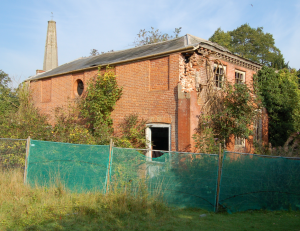

20 Hill Street, Mayfair, London
This lovely grade II-listed townhouse built in c1748-50 with alterations, located in the heart of Mayfair, has seen better days. There are signs of neglect and decay at the street facing elevation, particularly along the cornice, sash windows and Doric portico. Little is known about the condition of the interiors which are described in the Historic England listing as ‘good interior features including cut string stone staircase with wrought iron balustrade, original doorcases and delicate plasterwork to ceilings and friezes of ground and first floor principal rooms, marble chimney pieces to first floor rooms, etc.’. In a neighbourhood surrounded by finely preserved eighteenth century townhouses, the sad neglect of this building is striking.
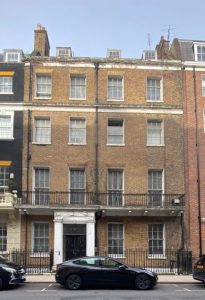
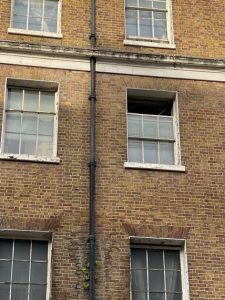
Talbot House, 13 High Street, Welford, Northamptonshire
Talbot House is situated within the prosperous rural village of Welford, now a conservation area. Unfortunately, this grade II-listed empty building has continued to deteriorate over a number of years, with multiple broken windows, rotting sash windows, failing render and brickwork. Permission was given to convert the building into smaller properties in 2021 but it appears the developers had issues with conditions placed on the applications. As a result, no work to stabilise or maintain the building has been performed, although safety scaffolding has been recently removed when the license expired. Talbot House is an important part of the history of Welford, formerly a manor house built in the mid-17th century and remodelled in the mid-and late 18th century, it became an important coaching inn where Charles Dickens is reputed to have stayed. It occupies a prominent position on the High Street and dominates the streetscape. The deterioration of this building is at odds with recent housing developments nearby and other properties in the village. The loss of such a grand building, full of potential, would have a significant impact on this historic village.
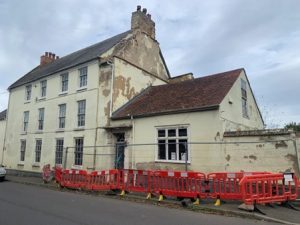
Buildings at Somerford Hall, Breewood, Staffordshire – Old Georgian Hay Barn, Sawmill and Summer House
This long-neglected Hay Barn forms part of a cohesive group of buildings at Somerford Hall. While Somerford Hall, a mid-18th century Palladian style country house grade II*-listed, is in excellent condition and operates as a wedding and conference venue, several of the outbuildings are in shocking condition. Along with the Hay Barn, there is also a Sawmill and Summer House, all grade II-listed and built around the same time as the country house. These buildings along with Somerford Hall form an attractive and cohesive group, which reflects the history of the estate and the wide range of functions that they were built to serve. It is a shame these buildings are not being restored and re-purposed to their full potential, the brickwork at the Hay Barn is particularly spectacular.
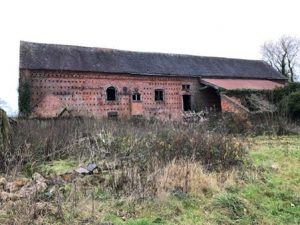
Old Union Flour Mill, 17-23 Grosvenor Street West, Birmingham, West Midlands
The Old Union Flour Mill, grade II-listed, was constructed as the New Union Mill in 1813 by Birmingham Flour and Bread Company. It was a significant industrial building throughout the 19th century, originally constructed in a rural location, which made use of the Birmingham Canal for the purpose of transport. It remained in operation until 1927 and was last used as an office and artists’ studios. This now at risk and empty building is in disrepair with crumbling bricks, rotting windows (all of which are covered with modern grills), and flaking plaster work. Plans were submitted for a residential development in 2018, subsequently refused, and an appeal submitted in 2020, also refused; there appears no resolution has been agreed upon to restore and re-purpose this significant industrial building.

Plas Nannau, Gwynedd
This once stately grade II*-listed country house in Wales has been empty for around 20 years and is increasingly deteriorating and at risk to vandalism. Plas Nannau was built between the years 1788 and 1805 by Sir Robert Hywel Vaughan, 1st Baronet and his son Sir Robert Willames Vaughan. The architect Joseph Bromfield designed the flanking pavilions, demolished in the 1960s, and was likely responsible for the internal decorations. In Gwynedd Pevsner, the site is described as “extraordinary” at 700 ft above sea level. From January 2020 Snowdonia National Park Authority became aware that lead from the roof had been removed, resulting in rainwater entering the building. Whilst the owner gave assurances temporary repair works would take place, no such works have been undertaken and it has proven difficult for the Authority to reach the owner. The Authority sought the expertise of a specialist contractor to determine what repair works are required to make the building watertight. The inspections have confirmed that the protection of Plas Nannau will be an expensive, time-consuming process and dependant on the provisions of relevant legislation. Various avenues are currently being considered, including an Urgent Repairs Notice. Funding routes are also being explored as it is likely the owner will not comply with the requirements of any notice served based on the lack of response and action thus far. Efforts to address the condition of the house are supported by CADW and the Society for the Protection of Ancient Buildings, all agree that urgent repairs are needed to prevent further decline of this significant country house.

Piercefield House, Monmouthshire
Piercefield House is a magnificent and important grade II*-listed country house that has been empty since the Second World War, steadily decaying year after year. It is now on the verge of collapse with only four roofless walls and two pavilions, once attached to the house by wings, which remain standing. A fine set of stables are decaying nearby the house. The property is owned by the Reuben Brothers, London based property developers, and is held by an offshore company. A campaign to save the house was launched by SAVE Britain’s Heritage in 2013, where they appealed to the developers to reunite the house with the parkland and consider any offer made on the house, however the house remains neglected and continues to deteriorate. This neoclassical masterpiece was designed by or to the designs of the famous architect Sir John Soane, built between the years 1786 and 1793. It is a fine example of Soane’s early work wrapped around an older Baroque house that might have been designed by William Tulman, Christopher Wren’s assistant. The pavilions, of a slightly later date, were designed by Joseph Bonomi the Elder. The house stands within Piercefield Park, a grade I-listed landscape, connected with the Picturesque and Romantic movements. The house is also hugely important in terms of location – as a gateway to Wales. The Reuben Brothers have a responsibility to either care for this beloved house or allow others to do so.
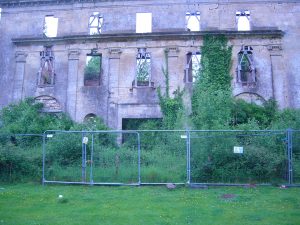
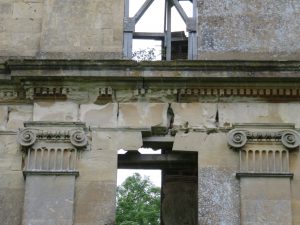
Pencerrig House, Llanelwedd, Powys
Another neglected country house in Wales is grade II-listed Pencerrig House, also included on SAVE Britain’s Heritage Building at Risk register. This once grand 18th century house, extensively altered in the 1830s, has been empty and at risk for vandalism for over a decade. It is now in a very poor state with a significant dry rot problem, leaking roof, and structural issues. Pencerrig House was home to the 18th century artist Thomas Jones, a very important Welsh Landscape Artist, known in his lifetime as a painter of Welsh and Italian landscapes. His reputation grew in the 20th century when previously unknown works, most notable a series of views of Naples that broke with the conventions of classical landscape painting, began to appear on the art market. His autobiography, Memoirs of Thomas Jones of Pencerrig, went unpublished until 1951 but it is now recognised as very important rare source material on the 18th century art world. The house passed through the family until it was split up and sold in the 1950s. It was then operated as a trekking centre and hotel but closed in 2008. Recently it has been vandalised as a cannabis factory by trespassing persons. The current owner seemingly has taken no action to protect and restore this significant national heritage asset and much-loved building for the local community. Concerned community members have organised a viability study and search for funding for urgent repair works to stop the leaks and dry rot from getting worse. They eventually would like to restore the house to its full potential as a museum to Thomas Jones and a coffee shop, but funding has to be raised and the absent owners would have to be willing to sell.
